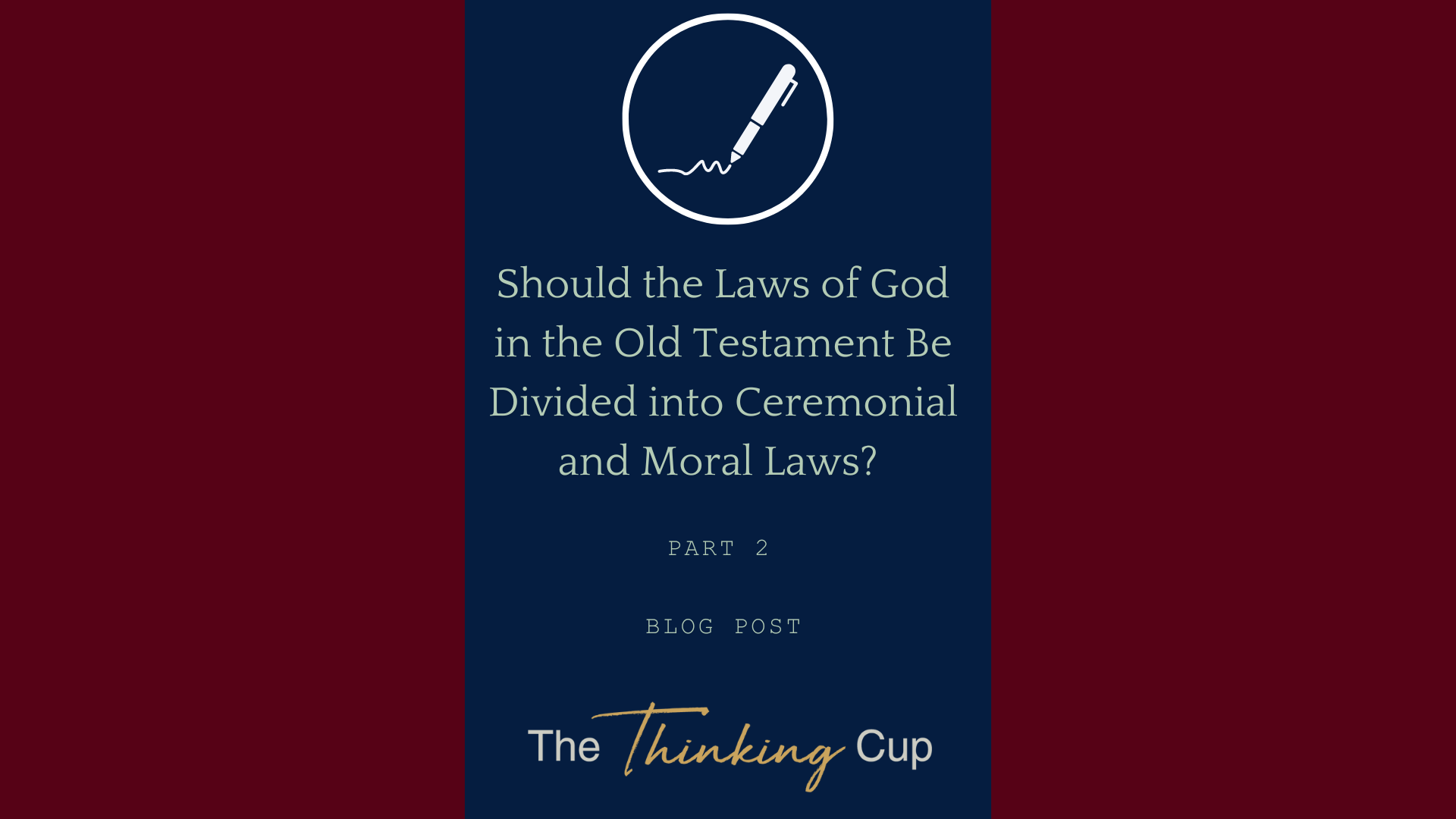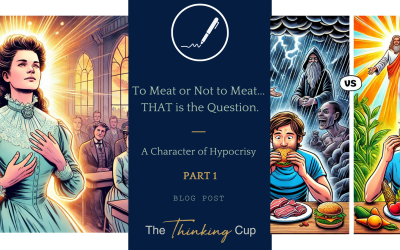The ceremonial Law of Moses has been abolished, but the Ten Commandments remain to be kept by all as God’s moral law. This is accomplished using the three-fold division of the law, separating the civil and ceremonial laws from the moral laws.
(This is part 2 of the discussion on the statement above. If you would like to read part 1, here is the link.)
Although it may appear to be effective initially, we need to ensure that our beliefs are driven by the text rather than by tradition or a specific method of interpretation. To achieve this, we must first ask how the Hebrew Bible and the New Testament readers understood the law concept. When Paul wrote about the Law, did he intend his audience to make distinctions between different aspects of it, or was he including it as a whole? Determining what the text allows and what is being added to it is essential. This is what we must strive to clarify.
“This threefold division of the law, however, is often questioned. Nowhere do we see, for example, that Moses divides the law of God according to moral, civil, and ceremonial distinctions. True enough. Yet some sort of distinction is apparent in Scripture itself. [1] For example, only the Ten Commandments are inscribed on tablets by God and deposited in the ark of the covenant.[2] The Ten Commandments are the first commandments given and are not limited to how to live in the Promised Land. [3] The Ten Commandments do not prescribe specific penalties [4] but are more like the framework for understanding the law as a whole. In these ways, they are different from other portions of the Mosaic law.
In addition, the Old Testament often makes a distinction between moral and ceremonial aspects of God’s law. As we will see in the discussion below of the Prophets, God’s people often kept the ceremonial aspects of God’s law—offering right sacrifices—even while breaking the moral law of God. Outward, ritual obedience is deemed insufficient where there is the lack of true love for God and neighbor. [5] And where there is no kingdom, God’s civil law is not the rule of the land (e.g., Esther). Even so, ceremonial and civil laws, while not in effect, continue to instruct us in what God requires, because they reflect the character and will of God. So, while a threefold division of the law may segment the law of Moses too sharply, we can at least speak of the threefold dimensions of the law.” [6] / [7]
It cannot be overstated that for the law to be eternal and still binding on every human in every age, there must be a separation of the law being discussed. Without this separation, all 613 laws in the Old Testament would be eternally binding on everyone, even though these laws were given to the Israelite nation during a theocracy.
One will quickly see that the law in the Old Testament was never seen in separate categories, even though we separate them today better to understand the function of the different types of laws. For the Jews, they were one unit.
In his book on the four different perspectives of the Sabbath, Craig Blomberg writes about a third common approach in the history of Christian interpretation. This is a lengthy quote, but it is necessary to understand what is being stated.
“…going back at least to Thomas Aquinas, has been to argue that the moral parts of the OT laws remain in force for believers, but the civil and ceremonial (or ritual) portion of the laws do not (see throughout Summa Theologica 100.3–11). The ceremonial laws are those that have to do with the animal sacrifices, the dietary laws, the annual festivals held in Jerusalem, and the like. They are those laws the violation of which rendered an Israelite ritually defiled or unclean until a period of time had elapsed and/or a sacrifice had been offered. The civil laws are those that were given to Israel for the establishment of its government, the ordering of its communities and its land, along with the people’s civic responsibilities, many of them unique even among the cultures in the ancient Near East. The moral laws, then, are the remaining commandments that deal with fundamental issues of right and wrong, often found in many of the world’s cultures and religions, which humans, perhaps by general revelation or the image of God that remains in them (though marred) even as unbelievers, almost universally acknowledge as dictating how people should or should not behave. These include commands against murder, adultery, theft, and greed, as well as stipulations in favor of loving God and others, honoring one’s parents, giving generously to the needy and dispossessed, and so on. [8]
This threefold division of the laws of ancient Israel proves more helpful than the first two options presented. Many laws fairly clearly fall into one of the three categories. Leviticus 19:1–4 commands holiness and honor of parents, while proscribing idolatry. Surely these are all moral laws. Verses 5–8 deal with ritual laws that accompanied ancient animal sacrifices, while gleaning reflects the civil law for everyday life in ancient Israel (vv. 9–10). Similarly, the laws that span verses 11–18 can all be viewed as moral: prohibitions of swearing falsely, defrauding, endangering, slandering, hating, retaliating, and denying justice. Verse 19 with its triad of “match, don’t mix” laws would appear to fall into the category of ritual injunctions, much like the dietary laws included specifications for not mixing different kinds of food in the same meal.[9] Other portions of legal material in Exodus through Deuteronomy likewise group together multiple examples of one of these three discrete categories of legislation.
But Leviticus 19, like numerous other portions of Torah, scarcely creates such groupings with any consistency. Moreover, plenty of laws defy simple categorization according to the taxonomy of moral, civil, and ceremonial. What, for example, are we to make of verse 27: “Do not cut the hair at the sides of your head or clip off the edges of your beard”? First of all, it is not even clear what this means at the level of original interpretation—that all men are to have forelocks that are never trimmed? that they must let their beards grow without ever shaving? or that it somehow offends God if, when they do shave, their beards become jagged-edged rather than neatly trimmed? Even if we could answer all these questions, would this be a ceremonial or a civil law? [10] It certainly doesn’t seem to be a moral law, but then a nagging thought comes to mind. Can anything that the God of the universe commands any people to do or not do be treated as amoral?
Indeed, doesn’t the source of all 613 commands of Torah somehow make it inherently a moral issue whether we obey them or not? Notice how often the commands of Leviticus 19—moral, civil, and ceremonial alike—end with a declaration such as, “I am the Lord (your God)” (vv. 3, 4, 10, 12, 14, 16, 18, 25, 28, 30–32, 34, 36–37). Going back to the issue of gleaning, shouldn’t this law be treated as a moral law even in the narrower sense of the expression since it has to do with care for the poor and outsider? And what on earth are we supposed to make of the command against tattoos in verse 28? About the only category this falls into that makes sense in a modern, scientific age is that it probably is a physically unhealthy practice. But this is never given as a rationale for the prohibition, and it is doubtful if the ancient Israelites even thought much in terms of its impact, good or bad, on one’s physical health. [11]
Possibly even more puzzling is the lack of any logical sequence of the laws in Leviticus 19 and in numerous other portions of the Torah. If the inspired writer had any fixed categories in mind, he has certainly not disclosed them through his outline or structure. Verses 20–22 deal with sacrifices (a ceremonial issue), but they also deal with fornication (a moral one). The laws of harvesting and eating fruit could readily be viewed as either ceremonial or civil. After that the progression seems virtually random—from not eating meat with blood still in it, to divination, to beards and tattoos, to prostitution, to mediums, to standing in the presence of the aged, to not mistreating foreigners, to using honest standards in the marketplace, and closing with a call to keep all of these laws. Equally “randomly,” tucked into this chapter are two references to keeping the Sabbath (vv. 4b and 30)! And we haven’t even asked yet into which of our three categories the Sabbath law would fall. The little NT letter of James, nevertheless, alludes to or quotes Leviticus 19 in at least seven places, recognizing the abiding validity of at least the verses it cites. And these range from the foundational calls to holiness and neighbor love (vv. 2, 18) to specific injunctions like not holding back a hired worker’s wages overnight and not showing partiality to the poor or favoritism to the rich (vv. 13, 15). [12] The Sabbath commands, however, like many other parts of the chapter, are not mentioned.” [13]
I hope it is beginning to become clear that significant challenges arise when we separate the Old Testament law into groups and then keep or ‘nail to the cross’ parts of those groups.
We will finish this discussion in part 3 of this post series. Buckle up, I think this is extremely important in our understanding of what the New Covenant system really is about!
[1] See also the distinctions in Irenaeus, Against Heresies, 4.16.4–5.
[2] Ferguson, Whole Christ, 150.
[3] Bruce K. Waltke with Charles Yu, An Old Testament Theology: An Exegetical, Canonical, and Thematic Approach (Grand Rapids, MI: Zondervan, 2007), 412–14.
[4] See also Richard P. Belcher Jr., The Fulfillment of the Promises of God: An Explanation of Covenant Theology (Fearn: Ross-shire: Mentor, 2020), 80.
[5] E.g., 1 Sam 15:22; Hos 6:6; see also Deut 10:16.
[6] Following Ferguson, Whole Christ, 143n14.
[7] Brandon D. Crowe, The Path of Faith: A Biblical Theology of Covenant and Law, Essential Studies in Biblical Theology (Downers Grove, IL: IVP Academic: An Imprint of InterVarsity Press, 2021), 49.
[8] See, e.g., W. A. VanGemeren, “The Law Is the Perfection of Righteousness in Christ,” in The Law, the Gospel, and the Modern Christian, ed. Strickland, 13–58; and W. C. Kaiser Jr., “The Law as God’s Gracious Guidance for the Promotion of Holiness,” in ibid., 177–99. Kaiser views his position as more of a conscious mediation between dispensationalism and covenant theology, but there is little difference in substance between VanGemeren’s views and his.
[9] “Lev. 11 pronounces unclean those animals that do not fit the normal categories. The division within the animal kingdom mirrored those within the human world, between clean and unclean men, between Israel and the nations.… This ban on all mixtures, especially mixed breeding, shows man following in God’s steps. He must keep separate what God created separate. As God separated Israel from among the nations to be his own possession, so they must maintain their holy identity.” G. J. Wenham, The Book of Leviticus (Grand Rapids: Eerdmans, 1979), 269. The decrees “against the mixing of things also contribute to the social consciousness that the holy is pure and unadulterated.” J. E. Hartley, Leviticus, WBC 4 (Dallas: Word, 1992), 318.
[10] As a result, C. J. H. Wright, God’s People in God’s Land: Family, Land, and Property in the Old Testament (Exeter: Paternoster, 1990), helpfully suggests that we need to create thematic categories of the Mosaic laws that go well beyond the simple moral, civil, and ceremonial divisions.
[11] See esp. M. Douglas, Purity and Danger: An Analysis of the Concepts of Pollution and Taboo (London and New York: Routledge, rev. 2001).
[12] See esp. L. T. Johnson, “The Use of Leviticus 19 in the Letter of James,” JBL 101 (1982): 391–401.
[13] Craig L. Blomberg, “The Sabbath as Fulfilled in Christ,” in Perspectives on the Sabbath (Nashville, TN: B&H Academic, 2011), 319–322.




0 Comments